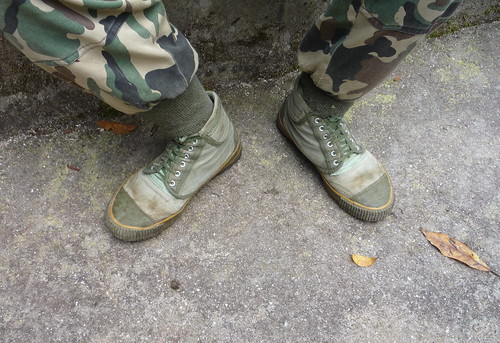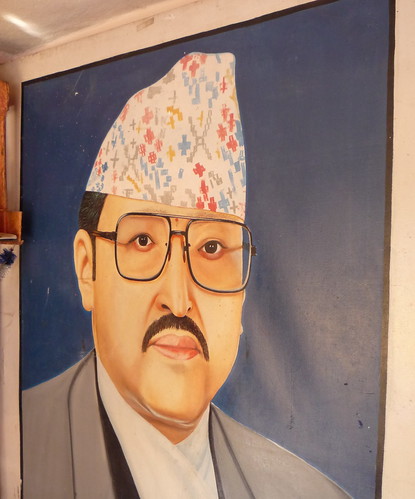Cement hauling by hand at the Institute for Agricultural Research near our house.
Monday, February 2, 2009
Wednesday, January 21, 2009
Garbage Time in Trash City
 In the last two weeks, garbage hasn't been collected in Kathmandu because of protests in the town where the city's main landfill, which is just about full, is located. As a result large piles of putrid trash- plastic bags, animal waste, rotting vegetable matter, newspapers- have begun accumulating in neighborhoods around the city. What can't be burned in the street stays in he street. 5,000 tons of it so far, according to one report, though that seems like an extreme lowball. The above was taken in the neighborhood of Jamal.
In the last two weeks, garbage hasn't been collected in Kathmandu because of protests in the town where the city's main landfill, which is just about full, is located. As a result large piles of putrid trash- plastic bags, animal waste, rotting vegetable matter, newspapers- have begun accumulating in neighborhoods around the city. What can't be burned in the street stays in he street. 5,000 tons of it so far, according to one report, though that seems like an extreme lowball. The above was taken in the neighborhood of Jamal.As for the protests. Like I've described here before, it's a time honored Nepali tradition to close down streets or whole cities in order to meet a political objective. In this case, the protests were over a lack of city money being given to the town that hosts the landfill. Seems like a reasonable complaint, and it looks like an agreement has been struck to reopen the road to the landfill.
But as soon as that deal was struck, a protest popped up at another of the city's landfills, this one having nothing to do with trash. Protesters at landfill #2 agitating against the thuggish behavior of the maoist-affiliated Youth Communist League, a member of which allegedly chopped the legs off a local youth. The protesters are demanding that whoever did it be arrested and tried, and until then: no garbage dropoffs.
Uma Singh
We're back in Kathmandu. Since we've been gone in late December, the general state of things in Nepal has inched toward, well, a failed state. Power cuts have increased to 16 hours a day (that's worse than Baghhdad). The metropolitan authority has stopped collecting garbage. Bird flu has blossomed on the southern border with India. And most heinously, Uma Singh a young woman journalist was hacked to death at her home in the Terai area in the south, where a violent brew of familial, ethnic, and political disputes have been boiling over in recent months.
Uma Singh's story captures some of the tragedy and lawlessness that are playing out here right now. Her brother and father were abducted and murdered by maoist insurgents during the war. She said she became a journalist in part to bring justice to her family, and she wrote critically about the maoists. Since then, the maoist party has been elected to lead the government in what by some measures is a remarkably peaceful transition from monarchy to democracy. But in another sign that the transition may not be so peaceful after all, a maoist party member has now been arrested and accused of her murder.
And while no one serious is accusing maoist party leadership in Kathmandu of direct involvement, the general problem for an insurgent group which came to power after a brutal ten year war is clear: its hard to control the violent elements of your movement even once you've taken power peacefully. In fact there's a whole group of thugs who are affiliated with the maoist party, but aren't fully within its control. It's called the Youth Communist League, or YCL, and it's been responsible for all manner of beatings, theft, and other mischief in recent months. It's also part of the reason that giant trash heaps are piling up all over Kathmandu right now (I'll post a picture in a minute).
Update: Uma Singh's in-laws have been arrested in connection with the murder. Police now say it was over a land inheritance dispute.
Uma Singh's story captures some of the tragedy and lawlessness that are playing out here right now. Her brother and father were abducted and murdered by maoist insurgents during the war. She said she became a journalist in part to bring justice to her family, and she wrote critically about the maoists. Since then, the maoist party has been elected to lead the government in what by some measures is a remarkably peaceful transition from monarchy to democracy. But in another sign that the transition may not be so peaceful after all, a maoist party member has now been arrested and accused of her murder.
And while no one serious is accusing maoist party leadership in Kathmandu of direct involvement, the general problem for an insurgent group which came to power after a brutal ten year war is clear: its hard to control the violent elements of your movement even once you've taken power peacefully. In fact there's a whole group of thugs who are affiliated with the maoist party, but aren't fully within its control. It's called the Youth Communist League, or YCL, and it's been responsible for all manner of beatings, theft, and other mischief in recent months. It's also part of the reason that giant trash heaps are piling up all over Kathmandu right now (I'll post a picture in a minute).
Update: Uma Singh's in-laws have been arrested in connection with the murder. Police now say it was over a land inheritance dispute.
Wednesday, December 31, 2008
Happy New Year
A radical maoist labor union has physically attacked the nepali news media, and shut sown the largest daily newspaper's printing press. Power cuts are set to reach an all time historic high this winter. But in the spirit of Peace, Love, and Truth I wish you all happy new years with a truck-painting of the Hindu Guru Sai Baba, who preaches all of those virtues.

I will be traveling for the next few weeks so the blog will be inactive (even more than usual) until the end of January.
Friday, December 12, 2008
Thursday, December 4, 2008
The Royals Around Town
It's been seven years since Nepal's royal family was massacred by its crown prince. Dipendra, who was an alcoholic and a gun enthusiast, walked into a family dinner at the royal palace one Friday, mowed down ten of his relatives with an M16, including his mother and father, then killed himself. At the end of it he'd committed fratricide, matricide patricide, sorocide, regicide, avunculicide, and suicide. The most disturbing part of all was that when he was finished he put down the gun and ordered a cide of fries. OK, OK, no he didn't.
After the massacre Nepal got a new king, Gyanendra. The Maoist insurgency escalated, and eventually a democracy movement took hold. Just this past year the monarchy was abolished and the country had it's first ever real nation-wide elections. So a lot's changed since the royal massacre.
And yet, walking around the city images of the royal family members involved in the event are still everywhere to be found. Stilted family photographs of Dipendra and his two parents hang in hotel lobbies, homes, shops, and restaurants.
 The above painting of King Birendra was done on the back wall of a sign making shop.
The above painting of King Birendra was done on the back wall of a sign making shop.These images, when you come upon them, have an unnerving and spooky quality, as though this gruesome and traumatic event never took place. They're not accompanied by an explanatory note saying "In Memory of King Birendra," or a gauzy effect indicating he's in heaven now. Just a faded image of a royal from a time before the prince murdered the family.
Yesterday I wandered into Nepal's Olympic Museum ( a one room shrine to the country's history in international sports) and found, on display, some of the family's event credentials, including Dipendra's. Who apparently was an avid Karate practitioner.
Friday, November 28, 2008
How Vegetarianism Affects Crime
 There are two daily English Language newspapers in Nepal, the Himalayan Times and the Kathmandu Post, and both can be frustrating in their lack of context. It's common to read a 750 word story about the progress of a criminal court case, in which the crime and the people involved is never described. Or a story about a politician's bitter accusations against a rival party, without any response from the accused, or any reporting on whether the accusations are true.
There are two daily English Language newspapers in Nepal, the Himalayan Times and the Kathmandu Post, and both can be frustrating in their lack of context. It's common to read a 750 word story about the progress of a criminal court case, in which the crime and the people involved is never described. Or a story about a politician's bitter accusations against a rival party, without any response from the accused, or any reporting on whether the accusations are true.But this week there came a story in the Himalayan Times about Kathmandu's quarterly crime statistics, and it had a really great sidebar on who the criminals are. Have a look.
(context on the context: the breakdown between vegetarian and non-vegetarian is a coded way of identifying high caste Brahmins, who are traditionally vegetarian.)
Subscribe to:
Posts (Atom)

